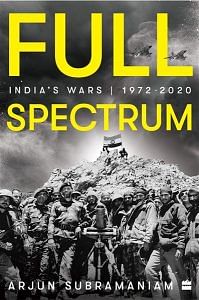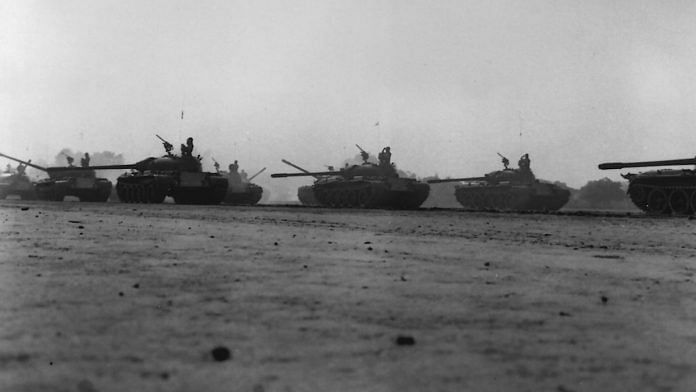When General Sundarji took over as army chief in 1986, he had several ideas for strengthening deterrence in the subcontinent. He was also convinced that a strong, modern and well-trained military was essential if India was to emerge as a leading power. However, barring a brief faceoff in the Rann of Kutchh during the prelude to the 1965 war, Sundarji did not have much combat experience. He made up for that with his varied operational assignments and powerful intellect. With his ideas about manoeuvre warfare and nuclear warfighting, Sundarji felt he was well-prepared to spearhead the transition of the Indian Army into a potent fighting force.
Sundarji planned Exercise Brasstacks as a massive air-land exercise that was conducted in three phases spread over several months with a final culmination by concentrating and exercising his forces in the Rajasthan sector. Sceptics however claim that Sundarji had little time for the air force, deeming it his manoeuvre arm in the third dimension.
In essence, Exercise Brasstacks involved two strike corps (1 and 2 Corps) with one carrying out the main thrust and the other feinting a subsidiary thrust. It was carried out in the Rajasthan and Gujarat sectors to determine whether they could cover good distance by night against moderate opposition. This raised alarm bells in Rawalpindi and Washington, and the Pakistan Army put its own operational plans into unscheduled play by moving its offensive formations towards India’s areas of vulnerabilities in Punjab and Jammu.
Lieutenant General Praveen Bakshi was a tank squadron commander in Skinner’s Horse, a T-72 tank regiment. Deployed for months in the desert during both Exercise Digvijay and Exercise Brasstacks, his recollections corroborate the conservative view that Sundarji had no intention of going to war. He says that though 7 Cavalry was the first unit to convert onto the T-72 tanks, Skinner’s Horse was the first to get deployed during Exercise Digvijay. 7 Cavalry joined them in Exercise Brasstacks. They easily covered sixty to seventy kilometres in a night and Bakshi recollects having done 800 kilometres on tracks.
Also read: General K Sundarji, soldier of the mind & still the most talked-about chief since Manekshaw
Despite pushing the T-72 to its limits, there were no breakdowns. As per him, the only drawback in the tank was the lack of effective night-vision devices. Exercise Brasstacks, he adds, was more of the same: long manoeuvres in the open deserts, simulated isolation and capture of small townships while engaging in tank vs tank battles. Bakshi says they never loaded ammunition into the tanks, so there was little chance of going to war. “We wouldn’t have flogged the tanks so much if we had to cross the border,” he says. He adds, “It was more of posturing and preparing ourselves for the future, as also sending a strong message across to the adversary of our overwhelming strength with modernised equipment like T-72 tanks and Infantry Combat Vehicles (ICV).”
Exercise Brasstacks, Exercise Trident, Exercise Chequerboard, Operation Falcon and Operation Hammerhead were all expressions of Sundarji’s desire to push the limits of deterrence and dissuasion. “His purpose really was the achievement of strategic objectives without having to fight a war.”
35 Squadron was the IAF’s only electronic warfare (EW) squadron in 1986. It was equipped with the Canberra bomber-cum-recce aircraft and MiG-21 aircraft that had been innovatively modified to carry Swedish electronic warfare pods. In the winter of 1986, the entire squadron was moved to two forward air bases – Ambala in the Haryana and Punjab Sector and Nal near the town of Bikaner in Rajasthan – and spent over two months escorting Jaguars and MiG-27 aircraft on simulated strikes as part of Exercise Brasstacks. On occasions, they even crossed a few kilometres over the border to check the alertness of the PAF’s air defence network. The moment the radar warning receivers beeped or if a warning was received over the radio, the entire formation would turn back. The game of cat and mouse continued for two months before all forces de-inducted.
Also read: The intellectual origin of India’s Cold Start doctrine lies in General K. Sundarji
Several of those Jaguar missions were led by Flight Lieutenant Bhadauria (now Air Chief Marshal) from 14 Squadron. ‘Chotu’ as he is still known, was probably the youngest large-mission leader during that period and was someone to look up to. He was crisp in his briefings, cool in the air and struck targets all the time.
Several new mission profiles emerged during these exercises as the IAF grappled with the danger posed by the PAF’s Crotale Surface-to-Air missile system. Among them was a Toss Bombing profile by Jaguars and MiG-23s/27s that involved a steep climb to 15,000 feet with a weapon release during the climb and a sharp break downwards with high Gs to stay outside the Crotale envelope. Unable to keep up with the Jaguars and the MiG-27s because of their heavy configuration with pods, the MiG-21s from 35 Squadron would stay low and skirt the target and rendezvous with the formation at a pre-planned point, gazing skywards to pick up their buddies and head back to base. For the pilots and navigators of 35 Squadron, it was just another instance of intensive training in near war-like conditions. The absence of any detailed briefings on what was going on gave rise to much speculation and discussion in the crew room on whether war was indeed around the corner.
 This excerpt from Full Spectrum: India’s War 1972-2020 by Arjun Subramanian has been published with permission from HarperCollins India.
This excerpt from Full Spectrum: India’s War 1972-2020 by Arjun Subramanian has been published with permission from HarperCollins India.






